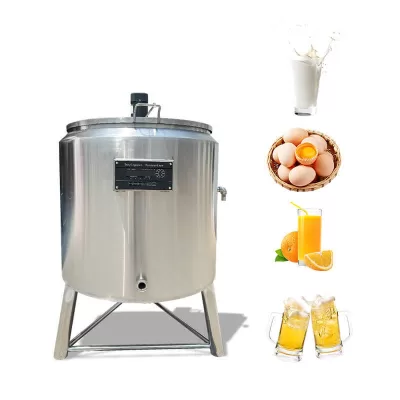A household milk pasteurizer is a small-scale device designed for home environments, aimed at performing pasteurization on milk. Pasteurization is a temperature treatment method intended to eliminate harmful microorganisms in milk at relatively lower temperatures while preserving the quality, taste, and nutritional value of the milk. This treatment is commonly used at home to extend the shelf life of milk, increase its safety, and reduce damage to its nutritional content.

**Features of a Household Milk Pasteurizer:**
1. **Temperature Control:** A household milk pasteurizer features precise temperature control mechanisms to ensure that milk is heated to the required temperature for pasteurization. This temperature is typically lower than that used in sterilization processes to maintain the desired product quality.
2. **Heat Exchange:** Household milk pasteurizers use various heat exchange methods, such as plate heat exchangers or tubular heat exchangers, to efficiently transfer heat to the milk. This helps ensure uniform heating and minimizes the risk of overheating or underheating.
3. **Time Control:** The duration of heat treatment is a critical factor in pasteurization. Household milk pasteurizers are designed to hold the milk at the required temperature for a specific amount of time to achieve the desired reduction in microbial load.
4. **Safety Features:** Modern household milk pasteurizers often come with safety features like alarms and automatic shut-off systems to prevent overheating or other malfunctions that could compromise product safety.
**Applications:**
1. **Home Food Processing:** Household milk pasteurizers are widely used for perishable foods produced at home, such as milk, fruit juices, sauces, and soups. Pasteurization of milk at home helps eliminate harmful bacteria while preserving its taste and nutritional value.
2. **Beverage Preparation:** Household milk pasteurizers are also suitable for use at home when making coffee, tea, and other beverages to ensure the safety and hygiene of the drinks.

**Operational Steps:**
1. Pour milk into the milk pasteurizer.
2. Set the appropriate temperature and time according to the product instructions.
3. Start the pasteurizer to heat it to the set temperature and maintain it for a certain period.
4. After heating is complete, remove the milk from the pasteurizer and allow it to cool.
5. The cooled milk can be safely stored or consumed.
In summary, a household milk pasteurizer is a device capable of performing milk pasteurization in a home environment. Through this method, harmful microorganisms can be eliminated, ensuring milk’s safety, and preserving its original quality.
